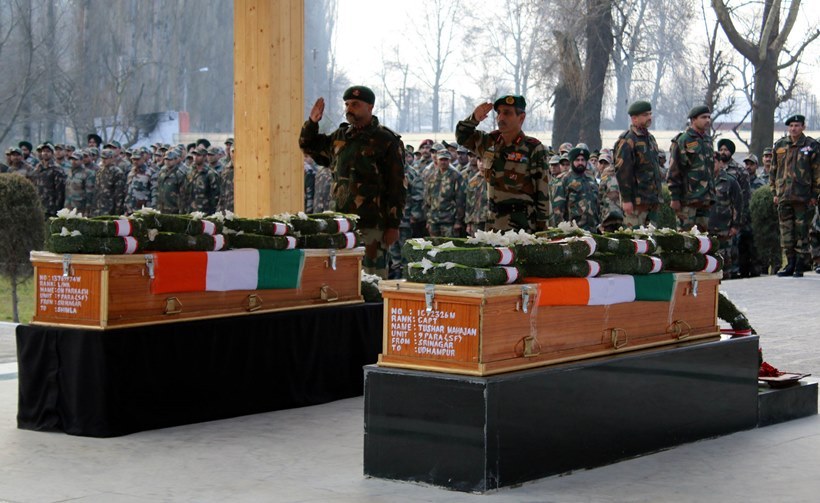Pampore Attacks: Battle on Two fronts
‘Jive Jive Pakistan’, ‘Hum kya chahte-Azadi’, ‘Jaago Jaago subah hui’, these were the slogans that welcomed armed forces as they battled terrorists holed up in the Entrepreneurship Development institute at Pampore, on the outskirts of Srinagar. The three day Pampore Attacks that martyred 5 brave Indian soldiers, saw the security personnel battle on two fronts simultaneously. On one side were the heavily armed and prepared terrorists and on the other ungrateful locals who did all they could, to demoralize the security forces. The level of ingratitude can be understood by the simple fact that the first task that the Armed forces executed upon reaching Pampore was to evacuate the civilians stuck in the institute. This prevented unnecessary loss of civilian lives during the encounter. Instead of showering the soldiers with roses for having saved the lives of innocent people, Mosques in the region played recordings that eulogized the terrorists. In many parts of Kashmir, a bandh was called, expressing solidarity with the terrorists.
Pampore Attacks: Militancy in Kashmir has come a full circle
Over the last few years, it seems like militancy in Kashmir has come a full circle. Analysts say, such provocation was the norm in the 90s, when militancy had just begun. Local terrorist sympathizers shielded and hid terrorists from security personnel. The Janazas of these terrorists used to be attended by hundreds of local civilians. However, over the years, the militants lost touch with the locals. Foreign terrorists’ high-handed ways, sops extended by government, strengthening of local police and a more humane approach by the armed forces eventually broke the back of the terrorists. For several years thereafter, militant strikes in the valley were believed to have been undertaken by foreign Mujahedeen. Ordinary Kashmiris, never too enamoured with violence, turned their back away from militancy and looked forward to development and peace.
Pampore Attacks: Vajpayee’s Insaniyat framework for Kashmiriyat
The opportunity for development and striking a chord with ordinary Kashmiris was taken up brilliantly by Vajpayee who talked of Insaniyat as a framework for Kashmiriyat. However, he was replaced before he could put his words into practice. The years of UPA were among the most peaceful in Kashmir in recent years. Analysts ascribe this to Vajpayee’s peace overtures as well as to successful assembly elections which provided an outlet for Kashmiris to express themselves. Analysts also believe that in spite of these opportunities, UPA failed to respond to the situation. Instead of going all out and decimating militancy with a combination of development, political space and military action, Kashmir did not feature prominently on UPA’s agenda. This has resulted in Kashmir slipping back to the dark ages. A new breed of home grown, foreign trained militants is now taking charge and attacking state institutions with increased ferocity. The promulgation of Governor’s rule has enabled political parties to play the worst brand of politics in order to secure a favourable deal for themselves. In spite of Modi’s several recent overtures, Kashmir is still on the boil. In spite of lakhs of crores that have been given to the state in the form of aid and assistance, Kashmir continues to see hardly any development as compared to other Indian states. Successive state governments have failed to channelize aid to the people and make a difference to their lives. PDP, for instance is openly believed to be soft on terrorists and empathizes with their agenda.
Pampore Attacks: The Xinjiang Condition
It might be worthwhile to compare the situation in Kashmir, a part of democratic India with Xinjiang, a part of Communist China. Xinjiang, like Kashmir, is (or at least used to be) a Muslim dominated area. In fact, it borders the state of Jammu & Kashmir. China has used relentless force and demographic conversion by settling ethnic Han Chinese in the territory to curb separatism. Religious life is heavily restricted and any transgressions are severely punished. Recent terror strikes by Uyghur militants saw massive retaliation from Chinese forces. Separatist sentiment, while prevalent, is curbed with an iron fist. Contrast this with India, where Human rights of terrorists take precedence over Human rights of Kashmiri civilians or Human rights of Armed forces. In India, it is more important to debate on freedom of speech and expression, for terrorists, for ant-nationals, for seditious elements. It is more important to have the right to talk about dismembering the nation. It is more important to have the right to conceive plans for secession of India’s states. However, any thought of curtailing Kashmir’s autonomy, detaining a terror suspect, a surgical strike against possible terrorists is a blatant violation of India’s constitution, it is an attempt to impose fascism and it is an affront to our democratic culture.
In the present circumstances, it seems that our Armed Forces are fighting at two fronts. The external enemy, visible and evident, dares them from time to time. Our armed forces have defeated this external enemy on multiple occasions in the past. The other enemy, propped up by the external foe, is more nefarious, he walks amongst us, speaks our language and seems no different from us. He subverts our principles, our ideals, our constitution and our democracy from within. As citizens of an ancient civilization that has survived numerous onslaughts through the ages and as people, who are raring to make this India’s millennium, we must be wary of such elements.
Defending his motherland during the 1947 war in Kashmir, Major Somnath Sharma, India’s first Param Vir Chakra awardee, had said, “”The enemy are only 50 yards from us. We are heavily outnumbered. We are under devastating fire. I shall not withdraw an inch but will fight to our last man and our last round.” May his words continue to inspire our countrymen
References:
